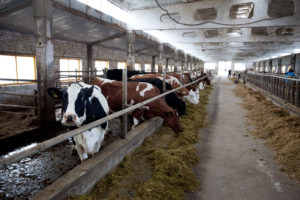Scientific view: Which bacteria could reduce greenhouse gas emissions in agriculture

Scientists at the Norwegian University of Life Sciences and the Institute for Applied Systems Analysis in Austria have discovered a method to reduce N2O emissions. The scientists foundbacteria that can break down nitrous oxide as it forms in the soil, preventing the gas from escaping into the atmosphere. Researchers believe that this method alone could reduce agricultural nitrous oxide emissions by a third.
Plants require a lot of nitrogen to grow, so productive agriculture requires nitrogen fertilizers. Nitrogen deficiency in the soil was a serious problem for agriculture until agricultural chemist Fritz Haber developed a technology for industrially producing nitrogen fertilizers from atmospheric nitrogen. Thanks to this technology, food production in the world has not lagged behind the rate of population growth for 120 years.
However, there are microorganisms in the soil that produce the greenhouse gas N2O, and fertilizers stimulate its production.
Nitrous oxide emissions are known to be regulated primarily by soil bacteria, making efforts to reduce them difficult due to their elusive nature. Scientists have been conducting fundamental research into how microorganisms convert nitrogen in soil for over 20 years. During this time, they have carefully studied what happens when microorganisms do not have access to sufficient oxygen, i.e., are in a state of hypoxia.
During heavy rainfall and fertilization, some areas of the soil become hypoxic. Since microorganisms do not have access to oxygen, they are forced to find other ways to obtain energy. Many of them can use nitrate instead of oxygen, and in a process called denitrification, microorganisms convert nitrate into other gases. One of these is nitrous oxide, and in this way, microorganisms contribute to greenhouse gas emissions.
The solution to reducing N2O emissions is to use a special type of bacteria that cannot produce nitrous oxide, but can reduce it to harmless nitrogen gas (N2).
Finding the right bacteria was not easy. It had to grow quickly on organic waste, function well in soil, and have a long lifespan to reduce N2O emissions during the plant's growing season.
Research is currently ongoing to find different types of nitrous oxide-consuming bacteria, testing them on different types of organic waste used as fertilizers in different climate zones. It is necessary to find a wide range of bacteria that can function in different types of soil and with different fertilizer mixtures.
Effective nature management and preservation of the ecosystem as a whole are important tasks. The All-Russian Plant Quarantine Center (FGBU "VNIIKR"), as a scientific center of ROSSELKHOZNADZOR , as part of the implementation of research work, is actively involved in the processes of finding solutions that, through a built system of quarantine phytosanitary safety, allow finding answers to a wide range of questions.
Elena Karimova,
PhD in Biology
Read together with it:
- An HSE expert reported on the "evolution of inequality" in access to healthcare.An HSE researcher analyzed Russians' access to healthcare over a ten-year period. In 2021, the influence of financial factors became noticeable for the first time: low income reduces the likelihood of visiting a DOCTOR.Over the ten years from 2011 to 2021, the number of Russians requiring medical care but not receiving it remained virtually unchanged, according to a study by Lyudmila Zasimova, hea...
- Rosselkhoznadzor has banned meat imports from two Belarusian enterprises due to violations.In addition, three other Belarusian producers are now subject to strict laboratory monitoring due to initial deviations: azithromycin was found in poultry MEAT from Druzhba Poultry Farm, and the pesticide imidacloprid was found in honey from Pchalyar Polachchyny Farm. Powdered MILK from Luninetsky Dairy Plant was also found to containcoli bacteria . These measures were taken at the request of the ...
- Pharmaceutical companies see a threat to EU security due to bacteria in UkraineAntibiotic-resistant superbugs have been detected in Ukrainian soldiers since the beginning of the conflict, and now they pose a threat to Europe, according to a foundation developing antibiotics.The Ukrainian conflict threatens Europe with antibiotic-resistant "superbugs," said Henry Skinner, CEO of the AMR Action Fund, which specializes in investing in antimicrobials. His article was published o...
- В Амурскую область поступило свыше 6 тысяч тонн мяса птицы из КитаяС 3 июня по 6 ноября инспекторы проверили 290 партий мяса, все из которых были сопровождены ветеринарными сертификатами, подтверждающими их качество и безопасность. Лабораторные исследования, проведенные под контролем Россельхознадзора, не выявили нарушений, и груз был допущен на территорию России.
- Китай рассматривает возможность введения пошлин на аргентинскую говядинуВ преддверии открытия новой Китайской международной импортной выставки (CIIE), одного из важнейших торговых мероприятий в мире, возникла проблема, затрагивающая всю цепочку поставок скота и мяса из Аргентины: китайское правительство ввело «защитную» процедуру в отношении импорта говядины. Эта мера, вступившая в силу в декабре 2......
- Scientists have identified a human virus comparable to COVID-19.The human respiratory syncytial virus (RSV) may be comparable in severity to influenza and CORONAVIRUS. This is the conclusion reached by Singaporean researchers collaborating as part of the PREPARE program, according to the press service of the Singapore General Hospital. Scientists conducted three studies to assess the severity of the disease, the risk of cardiac complications, and its long-term...
- «Новые воротнички»: почему компании начали ценить кандидатов без дипломаНа рынок труда хлынула волна новых воротничков — высококлассных специалистов без высшего образования. Как пересмотреть подходы к найму, чтобы не упустить самых перспективных из них, рассказывает Алексей Клочков, основатель HR-tech компании Happy Job Раньше большинство компаний при найме сотрудников уделяло повышенное внимание диплому. Однако теперь, поступая таким образом, они лишь создают себе пр...


